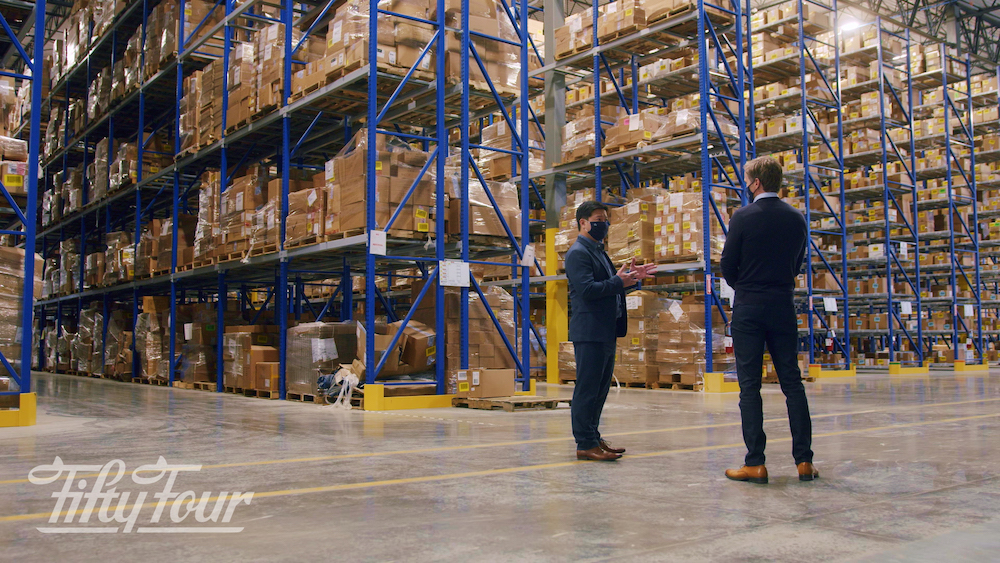
Many in the material handling and distribution center warehouse industry were caught short by the pandemic and the resulting boom in e-commerce. Sure, e-commerce has been steadily rising across the board for years – and many of us were slowly but surely adapting our operations to handle the increase. But the early days of our first pandemic caused a massive and sudden spike in customers turning to the Internet to find and order their items.
For those of us who pivoted and learned quickly how to make the best use of innovative technology to handle this crush of business, life has been hectic but good. For others who came a little later to the e-commerce craze, their business should be steadily improving since e-commerce isn’t slowing down. And for some who have held onto the old ways, business has been hard.
E-commerce happens all year. And now that those who are in the business of buying and selling are used to doing business this way, things won’t slow down. However, many people in the material handling and DC warehouse arena can see a certain peak and ebb during the year when goods are moving faster and more often. If you can learn when your warehouse is typically peaking and ebbing, you can make smart, strategic decisions about your warehouse design, your equipment and worker needs, as well as a myriad of other business decisions intended to set you apart from your competition and boost your bottom line.
When Is Peak Season in the Warehouse Business?
For most – if not all – of us in the e-commerce fulfillment business, peak season is going to be starting in October and ending sometime in January. Online holiday sales grew by close to 50% beginning in 2020 and continue today. Even as pandemic-weary people want to go out and shop like the old days, versions of Covid are still coming around. Plus, shoppers have grown accustomed to the convenience of doing their holiday shopping online – and the savvy material handling and DC warehouse manager has taken this and turned it into a very fast throughput and an easy return system.
The Challenges to Peak Warehouse Times
For the vast majority of those in the business of storing and shipping goods and products, this seasonal holiday is going to be the peak time for seeing your operations get and stay busier. So, let’s talk about the challenges and solutions for not only staying sane during this peak time, but flourishing. What are some of the challenges facing the material handling and DC warehouse industry, especially during busy times?
- Worker availability: All industries are dealing with a decrease in employee availability. Those of us in the warehouse business have been watching our worker pool get smaller every year for a long time. Competition is ferocious for the workers that are available. How can you prepare for your upcoming peak time when workers are just not available?
- Warehouse operations: The time to get your warehouse in a smooth rhythm is before your peak time. During the slower months is when you should be conducting an audit to find out how you can improve the receiving, storing and shipping of products and goods.
- Investing in new technology: It’s out there and you know it. It can be expensive and a little bit of a time sink to explore the new warehouse and equipment technology, much less install it and learn how to use it. But what if the steps you take now, when it’s not your busiest time, could help you combat your worker shortages, your warehouse operations and many more of your pain points?
- Keeping your customers happy: Life would be so much simpler if we didn’t have to spend so much time dealing with pesky customers, right? From those we buy from, those we store for and the end-user, Mary at her computer who keeps returning stuff – our world revolves around being efficient and productive for our customers if we want to be successful. The successful entrepreneur has learned how to balance doing the work behind the scenes to keep the customers “in the audience” clapping and cheering for more.
There are plenty more challenges we can think of that keep us on our toes during our peak times. But let’s take a look at some of the solutions.

The Solutions to Peak Warehouse Times
John F. Kennedy said: There are risks and costs to action. But they are far less than the long-range risks of comfortable inaction.
Times of great change and upheaval affect different people in different ways. For some, it may be time to move into something new and different. For others, it’s a call to action. As Kennedy said, there are risks to action – but you can mitigate the risks, while still enjoying the benefits, by putting one foot in front of the other. Taking baby steps – especially during your slow months, when you have more time to examine and ask questions, as well as train on new products, can move you into a winning spot come October. Let’s take a look at some of the “new” methods to bring you up to speed and handle the challenges we mentioned before.
- Worker availability: Workers are probably not going to show up in droves at your warehouse in September or October. That’s why you need to start early to plan how to work around your chronic worker shortage. And one way to do that is to start introducing automation into your material handling and DC warehouse. How does that work? Automation of certain mundane and repetitive tasks, such as order picking, can free up the workers you have for more complex duties. Bonus: Automation cuts down on workplace repetitive motion injuries, which means your workers comp payment may go down.
- Warehouse operations: A properly-employed warehouse management system (WMS) keeps track of everything in the warehouse so inventory is always up to date in real time. Another vital feature of a WMS is keeping track of your warehouse operations from receiving to storing to shipping. Sounds expensive, right? The average monthly cost for a basic WMS is $167, but can go as high as $5,000 a month depending on the bells and whistles you add. If you buy the software, rather than subscribe monthly, the basic introductory price averages around $2,500. Of course, your price depends on the size of your operation and what all you want your WMS to do.
- Investing in new technology: Like the automation and WMS mentioned above, new technology is out there for the express purpose of bringing your business into an efficient and competitive sphere. New technology can be as little as installing RFID tags and trackers (cheap) to the highest level of automation (expensive). The great thing about using new innovations and technology in your warehouse is you can start small and immediately start seeing a beneficial ROI.
- Keep the customer happy: Of course, the best way to keep your customer happy is to always be prompt, do what you say you will, have an affordable (or at least competitive) cost and be accommodating. But how can you accomplish these things while trying to run a business? Obviously, your business depends on keeping your customers happy and one way you can do that is to have clear expectations and communications. When your outbound customers can clearly see where their stuff is and when they will get it, they’ll be happy. Your inbound customers want to see their goods unloaded in a timely manner and stored with no damage. Your new WMS can communicate these things so you don’t have to turn away from the important business of running your business!
Learning how to manage your peak material handling and DC warehouse seasons is vital to the success of your business. Taking time during slower seasons to incorporate new technology that will help you optimize your operations is the key to winning the e-commerce game. At 54 Intralogistics, we have professional warehouse experts standing by all over the country to give you a free warehouse audit. Our goal is to help you find your MaxOP – maximum operating potential. Contact us today to learn more.
